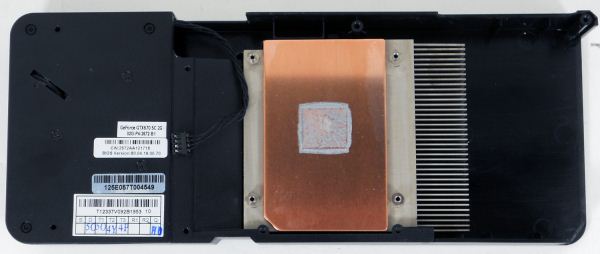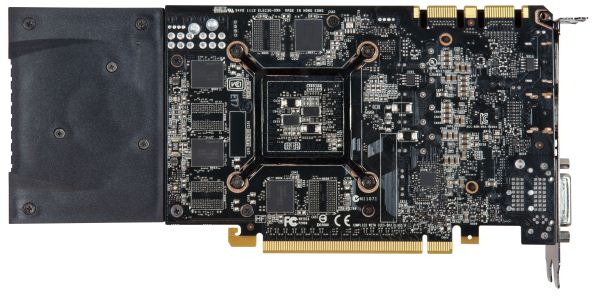NVIDIA GeForce GTX 670 Review Feat. EVGA: Bringing GK104 Down To $400
by Ryan Smith on May 10, 2012 9:00 AM ESTMeet The GeForce GTX 670
Because of the relatively low power consumption of GK104 relative to past high-end NVIDIA GPUs, NVIDIA has developed a penchant for small cards. While the GTX 680 was a rather standard 10” long, NVIDIA also managed to cram the GTX 690 into the same amount of space. Meanwhile the GTX 670 takes this to a whole new level.
We’ll start at the back as this is really where NVIDIA’s fascination with small size makes itself apparent. The complete card is 9.5” long, however the actual PCB is far shorter at only 6.75” long, 3.25” shorter than the GTX 680’s PCB. In fact it would be fair to say that rather than strapping a cooler onto a card, NVIDIA strapped a card onto a cooler. NVIDIA has certainly done short PCBs before – such as with one of the latest GTX 560 Ti designs – but never on a GTX x70 part before. But given the similarities between GK104 and GF114, this isn’t wholly surprising, if not to be expected.
In any case this odd pairing of a small PCB with a large cooler is no accident. With a TDP of only 170W NVIDIA doesn’t necessarily need a huge PCB, but because they wanted a blower for a cooler they needed a large cooler. The positioning of the GPU and various electronic components meant that the only place to put a blower fan was off of the PCB entirely, as the GK104 GPU is already fairly close to the rear of the card. Meanwhile the choice of a blower seems largely driven by the fact that this is an x70 card – NVIDIA did an excellent job with the GTX 560 Ti’s open air cooler, which was designed for the same 170W TDP, so the choice is effectively arbitrary from a technical standpoint (there’s no reason to believe $400 customers are any less likely to have a well-ventilated case than $250 buyers). Accordingly, it will be NVIDIA’s partners that will be stepping in with open air coolers of their own designs.
Starting as always at the top, as we previously mentioned the reference GTX 670 is outfitted with a 9.5” long fully shrouded blower. NVIDIA tells us that the GTX 670 uses the same fan as the GTX 680, and while they’re nearly identical in design, based on our noise tests they’re likely not identical. On that note unlike the GTX 680 the fan is no longer placed high to line up with the exhaust vent, so the GTX 670 is a bit more symmetrical in design than the GTX 680 was.

Note: We dissaembled the virtually identical EVGA card here instead
Lifting the cooler we can see that NVIDIA has gone with a fairly simple design here. The fan vents into a block-style aluminum heatsink with a copper baseplate, providing cooling for the GPU. Elsewhere we’ll see a moderately sized aluminum heatsink clamped down on top of the VRMs towards the front of the card. There is no cooling provided for the GDDR5 RAM.

Note: We dissaembled the virtually identical EVGA card here instead
As for the PCB, as we mentioned previously due to the lower TDP of the GTX 670 NVIDIA has been able to save some space. The VRM circuitry has been moved to the front of the card, leaving the GPU and the RAM towards the rear and allowing NVIDIA to simply omit a fair bit of PCB space. Of course with such small VRM circuitry the reference GTX 670 isn’t built for heavy overclocking – like the other GTX 600 cards NVIDIA isn’t even allowing overvolting on reference GTX 670 PCBs – so it will be up to partners with custom PCBs to enable that kind of functionality. Curiously only 4 of the 8 Hynix R0C GDDR5 RAM chips are on the front side of the PCB; the other 4 are on the rear. We typically only see rear-mounted RAM in cards with 16/24 chips, as 8/12 will easily fit on the same side.
Elsewhere at the top of the card we’ll find the PCIe power sockets and SLI connectors. Since NVIDIA isn’t scrambling to save space like they were with the GTX 680, the GTX 670’s PCIe power sockets are laid out in a traditional side-by-side manner. As for the SLI connectors, since this is a high-end GeForce card NVIDIA provides 2 connectors, allowing for the card to be used in 3-way SLI.
Finally at the front of the card NVIDIA is using the same I/O port configuration and bracket that we first saw with the GTX 680. This means 1 DL-DVI-D port, 1 DL-DVI-I port, 1 full size HDMI 1.4 port, and 1 full size DisplayPort 1.2. This also means the GTX 670 follows the same rules as the GTX 680 when it comes to being able to idle with multiple monitors.
















414 Comments
View All Comments
SlyNine - Sunday, May 13, 2012 - link
The 5800 ultra was pretty bad. the 2900XT was pretty bad to. And god forbit if you actually payed for the 5200ultra.The Geforce 2 ultra was a bad value (even tho I bought one of those).
celestialgrave - Thursday, May 10, 2012 - link
"The only other change you’ll notice is that <b>NVIDIA</b> is using their own high flow bracket in place of NVIDIA’s bracket. The high flow bracket cuts away as much metal as possible, maximizing the area of the vents. Though based on our power and temperature readings, this doesn’t seem to have notably impacted the GTX 670 SC."First Nvidia meant to be EVGA?
Ryan Smith - Thursday, May 10, 2012 - link
One would assume so. Thanks.Lepton87 - Thursday, May 10, 2012 - link
Ever since 6870 launch you had strict policy of no OC cards in launch articles yet you did it again. Where's the consistency?Ryan Smith - Thursday, May 10, 2012 - link
To be clear, our policy is no COMPETING OC cards in a launch article. You guys have specifically indicated that you want us to avoid the FTW scenario. If someone launches a competing card at the same time as another major launch, that card will be in a separate article and judged as such.However we've bundled retail cards into reviews for quite some time; this isn't any kind of change. It allows us to quickly cover semi-custom cards that are similar to the original while not being redundant.
raghu78 - Thursday, May 10, 2012 - link
The HD 6870 review was HD 6870 stock with GTX 460 OC. Now you have 670 and 670 OC cards in this review. I don't see any problems in a HD 7950 OC being pitted against a 670 OC.silverblue - Thursday, May 10, 2012 - link
Yes, but we're talking the 670 vs. overclocked 670s. The 6870 review threw an overclocked 460 into the mix which takes a lot of attention away from the actual card being reviewed.Any overclocked AMD vs. NVIDIA comparisons should be made in a separate article.
RussianSensation - Thursday, May 10, 2012 - link
It's extra data being presented. If you don't want to read it, just ignore it. It doesn't hurt the review in any way. If anything it shows that an overclocked 7950 has NO CHANCE to match an overclocked 670. The direct competitor to the 7950 is therefore superior based on this review. It's not necessary to see HD7950 oced vs. 670 per say given the massive performance lead in games such as BF3, Batman AA, etc. HD7950 no longer makes any sense for $399.Morg. - Thursday, May 10, 2012 - link
TWIMTBP v2.0 : now hidden for more nerdrage and forumwarsRussianSensation - Thursday, May 10, 2012 - link
Well some people here are always too quick to blame fanboys on logical arguments and facts:"With performance that comes awfully close to a fully enabled GK104, the GTX 670 poses a nightmare scenario for AMD. Fresh off a round of price drops, they now have to contend with a card that retails for the same price as a HD 7950 but runs dead even with a HD 7970 in everything except multi monitor resolutions. To add insult to injury, the Radeon cards fight a losing battle in the performance per watt and acoustics categories as well. Free game offer or not, without another $50 to $75 shaved off, we can’t think of a single scenario where a gamer should choose a Tahiti-based card over the GTX 670. "
http://www.hardwarecanucks.com/forum/hardware-canu...